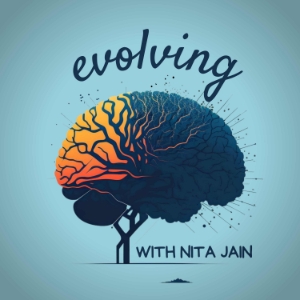
Evolving with Nita Jain: Health | Science | Self-Development
Health & Wellness Podcasts
Whether it's a workout protocol, productivity routine, or mindfulness practice, Nita Jain shares actionable insights designed to help listeners optimize their lives and become their best selves. Topics covered include science, psychology, philosophy, health, fitness, longevity, entrepreneurship, and everything in between. The show aims to be interdisciplinary, encourage forward thinking, and approach subject matter in a balanced way.
www.nitajain.com
Location:
United States
Genres:
Health & Wellness Podcasts
Description:
Whether it's a workout protocol, productivity routine, or mindfulness practice, Nita Jain shares actionable insights designed to help listeners optimize their lives and become their best selves. Topics covered include science, psychology, philosophy, health, fitness, longevity, entrepreneurship, and everything in between. The show aims to be interdisciplinary, encourage forward thinking, and approach subject matter in a balanced way. www.nitajain.com
Twitter:
@HealthUnveiled
Language:
English
Get a Grip: Why Teaching to the Test Doesn't Work
Duration:00:01:54
Spooniverse Directory Demo
Duration:00:03:00
The Trouble with EHR Data
Duration:00:03:32
Exploring the Intersection of Privacy, Tech, and Human Health with Zama CEO Rand Hindi
Duration:00:38:07
What is the Quantified Self?
Duration:00:02:08
Why Probiotics Can’t Always Colonize the Gut
Duration:00:00:57
Deciphering the Gut Microbiome & Quantifying the Self with Tech Executive Richard Sprague
Duration:00:48:53
Confessions of a COVID Long Hauler
Duration:00:09:27
How to Train & Overcome Adversity with Ironman Athlete Charlie Rogers
Duration:01:04:32
How to Have a More Equal Partnership: Gender Roles, Social Conditioning, Cognitive Labor, & Maternal Gatekeeping
Duration:00:09:08
Strategies to Manage Stress & Anxiety
Duration:00:12:12
Better, Faster, Stronger: How Stress Can Fuel Personal Growth and Development
Duration:00:14:36
A Mindset of Indulgence Can Improve Your Metabolic Health
Duration:00:12:44
The Insanely Simple Life Hack You Need to Boost Happiness and Creativity
Duration:00:11:05
4 Tips to Help You Engage in More Productive Disagreements
Duration:00:08:29
How to Stay Calm When Triggered
Duration:00:06:53
How to Predict Human Behavior More Effectively
Duration:00:06:44
How to Negotiate Better: The Daylight Saving Time Debate as a Case Study
Duration:00:06:50